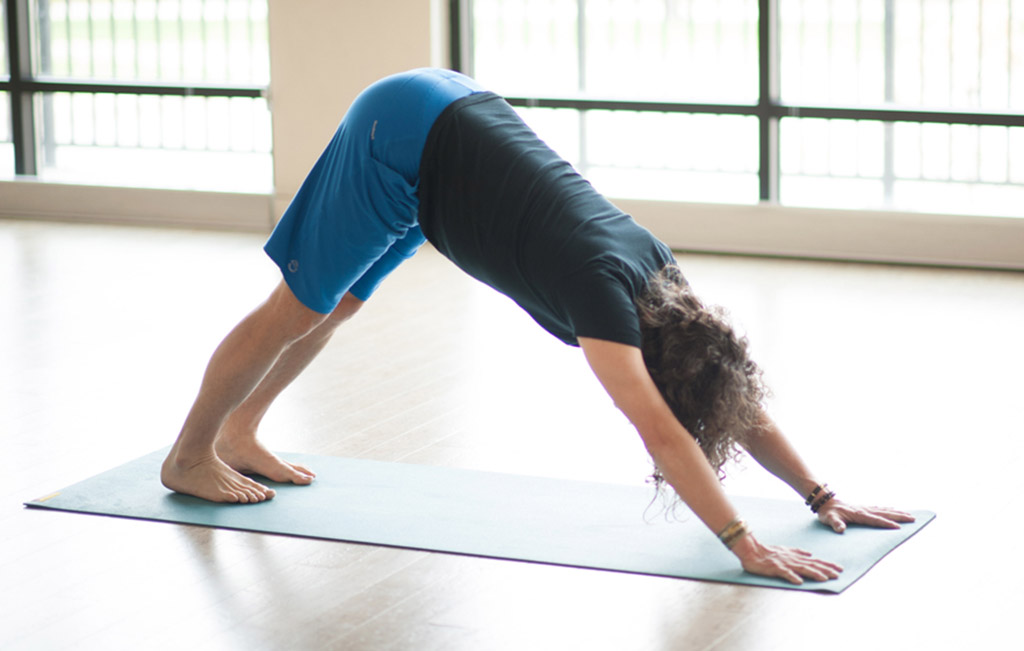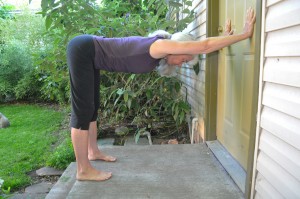
Adho Mukha Svanasana, commonly known as Downward Facing Dog Pose or simply Dog Pose, is arguably the most ubiquitous of poses. Yoga teacher Donna Farhi calls it the “‘garlic’ of yoga poses—a panacea for whatever ails you.”
Adho Mukha Svanasana is simultaneously an inversion, an arm balance, a forward bend and a restorative pose. It opens your shoulders, strengthens your arms, lengthens your spine, stretches your legs, inverts your internal organs and nourishes your brain. It invigorates and calms. For dogs and cats, Dog Pose is the equivalent of a morning cuppa, a remedy that clears sleep-induced physical and mental cobwebs.
Downward Facing Dog Pose is most beneficial when we align our bodies so that the lines of force from the hands to the sit bones, and from the heels to the sit bones are continuous and unbroken. In either Dog or Wall Dog (see photos), our own bodies give reliable alignment feedback. When you are aligned, pressing your hands into the floor or wall will cause your sit bones to rise upward (or backward). The same will happen when you press your feet into the floor.
How to Practice Adho Mukha Svanasana
- Begin on hands and knees on a yoga mat. Root the palms of your hands evenly into the floor, and spread and stretch your fingers outward. As a short warm-up, bow your spine upward, drawing your navel toward your spine, rounding your back, and letting your head hang (Cat Pose). Then draw your spine into your back, letting your back sway, and look straight ahead (Cow Pose). Repeat this alternation several times, coordinating your movements with your breathing. Return to neutral.
- On an exhalation, round your spine upward into Cat Pose. As your navel and abdominal organs draw into your back, let that movement propel your body upward as you straighten your arms and reach your pelvis up toward the sky.
- With your knees generously bent, now straighten your spine, lengthening out through your arms as you root your hands and fingers. Widen your shoulder blades outward and lengthen the back of your neck. Gradually begin to straighten your legs, as long as you can maintain your natural spinal curves.
- Your heels do not need to touch the floor. If your heels can’t touch the floor without sacrificing your natural spinal curves, it’s better to lift your heels. Feel free to place a yoga wedge under your heels to allow your heels to ground while maintaining a neutral spine. If the wedge isn’t high enough to help you accomplish this, no worries. Just keep your heels off the floor. (Note: I’m extremely flexible, but after 36 years of practice, my heels don’t touch the floor. So don’t sweat it!)
- Take care not to collapse your ribcage toward the floor. Instead, draw your abdominal organs back into your back, giving frontal support to your spine, so that the line from your hands to your pelvis is continuous and your front, back and internal bodies are stretching equally.
- Avoid collapsing into your shoulders. This may help your head move closer to the floor, but it comes at a price. When you collapse, your upper body’s continuity breaks at the shoulders, inhibiting the flow of force from your hands to your hips. This weakens your arms and causes your weight to fall into your hands and wrists. Lifting your shoulders will restore integrity to your pose.
- Your first Adho Mukha Svanasana of the day is a great opportunity to play. Pump your legs, alternately bending one and stretching the other. Twist and turn. When you do settle into your pose, let all your joints be malleable and mobile, and breathe deeply, letting your body dance around the wavelike motion of your breath.
- Stay five to ten breaths before returning to all fours.
 Ubiquitous as it is, Dog Pose is not for everyone. If you have carpal tunnel syndrome, glaucoma, detached retina, uncontrolled high blood pressure or disc problems, practice Wall Dog instead. In Wall Dog, you stand facing a wall, press your hands into the wall and walk your feet back so that your body is in an approximate “L” shape. Wall Dog feels great for anyone, flexible or inflexible. I practice it with my hands on the countertop while I boil my morning tea water. It’s a great pick-me-up in the middle of a long day at the computer or at rest areas on road trips.
Ubiquitous as it is, Dog Pose is not for everyone. If you have carpal tunnel syndrome, glaucoma, detached retina, uncontrolled high blood pressure or disc problems, practice Wall Dog instead. In Wall Dog, you stand facing a wall, press your hands into the wall and walk your feet back so that your body is in an approximate “L” shape. Wall Dog feels great for anyone, flexible or inflexible. I practice it with my hands on the countertop while I boil my morning tea water. It’s a great pick-me-up in the middle of a long day at the computer or at rest areas on road trips.
When I watch my cats do Downward Facing Dog Pose, their pleasure is palpable. Their whole bodies vibrate with life. When we humans do it, it often looks and feels as if we are forcing and struggling. Relax. There is no “final” position to attain. Let your pose move and vibrate. Let your revitalizing breath flow through.
Updated article from June 26, 2012
